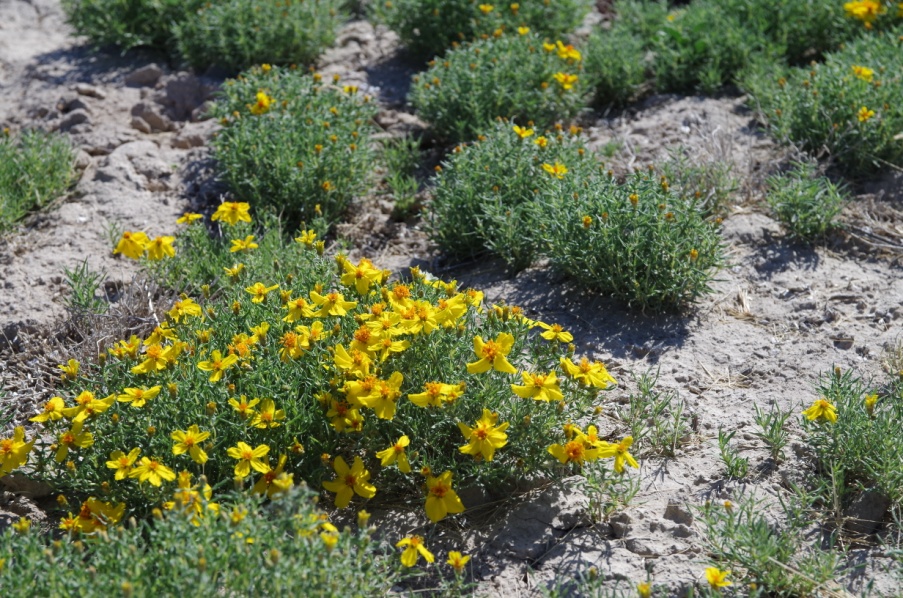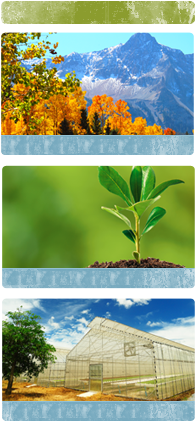Desert Zinnia in the Landscape

Stephen Love, University of Idaho
Scientfic Name: Zinnia grandifloraCommon Name: Desert zinnia, Rocky Mountain zinnia, wild zinnia
Description: Desert zinnia is a small, spreading perennial that can double as a either a border plant or a groundcover in a xeric landscape. When mature, plants are only about 6 inches tall but slowly increase in width until several feet across. During the winter season, the plants die back to below ground, virtually disappearing until regrowth appears in May. The leafy stems are thin but tough and wiry. The light green leaves are small, narrow, twisted, and covered with bristly hairs. The foliage is interesting but not striking. The showy nature of this plant emerges in June when the plants cover themselves with large, flat, papery, dark yellow flowers. Bloom typically lasts about 14 weeks, ending in October. Desert zinnia can be used in xeric beds or borders, as a ground cover around larger plants, or as a dry rock garden specimen, but is probably at its best when planted along pathways or edges of informal gardens.
Native Habitat: Zinnia grandiflora inhabits dry, open sites with sandy or gravelly alkaline soils. It populates many ecosystems - with a corresponding range of companion plants - such as open grasslands, dry hills and mesas, and rocky woodlands. This widespread species is native to several southwestern states and grows at elevations ranging from 3,000 to 7,000 feet.
Cultural Requirement
Soil: Prefers loose, well-drained, alkaline soils but will adapt to almost any soil type with good drainage. Spreads more slowly in heavy soils. Requires minimal soil fertility.
Moisture Tolerance: Tolerant of a wide range of moisture conditions from dry to moderately moist. Requires some supplemental water to remain healthy and bloom consistently.
Sun/Shade/Preference: Prefers full sun but will tolerate light shade.
Transplanting: Easily transplanted from pot to pot and from pot to the garden. Potted plants grow at a moderate pace after transplanting and consistently bloom profusely the first season.
Propagation: Best grown from seed. Seeds require no stratification or other treatment and consistently germinate at high rates. Young seedlings grow very slowly and require good pot drainage to survive the first few weeks. Do not overwater in the seedling stage. Small seedlings experience transplant shock – allow development of 5 to 7 leaves before teasing plants out of flats. Plants bloom in the pot when quite small. With good watering practices, plants are suitable for culture in pots up to 1-gallon size.
Maintenance (pruning, fertilization, deadheading, division, irrigation, etc): Desert zinnia is a carefree species and requires only spring cleanup to maintain appearance. Plants will grow and spread faster with some supplemental irrigation. Fertilizer is required only if plants show poor vigor.
Insect, disease, or other problems: Desert zinnia has no known common disease or pest problems.
Landscape Value
Use in the Landscape: Desert zinnia is at its best when massed to enhance visibility. It provides a colorful base from which an attractive xeric garden can be created. As a companion plant, it can be planted among and around taller perennials and shrubs. As a groundcover, it provides a long season of color to low beds, borders, and planting strips. It functions well in hell-strips and other harsh sites and can be used to stabilize slopes.
Weediness/Invasive Potential: Desert zinnia is not weedy from seed, but will slowly spread from rhizomes. It should not be planted where its spreading habit will be problematic.
Foliage: Plants of desert zinnia branch freely at the base, creating a dense mound of coarse foliage. The stems are wiry; the leaves small, narrow, and twisted. Alone, the foliage lacks significant appeal.
Flower: The dark yellow, papery flowers are large (2+ inches) in relation to size of the plant. Each large flower is actually a composite head but the shape is unusual for a species in the aster family; four symmetrical ray flowers on the outside and a small number of orange disk flowers in the center. Flowers are plentiful and completely cover the foliage when plants are in full bloom.
Timing: June-October.
Fruit: Each flower head produces several fruits consisting of flattened, gray achenes (seeds).
Form: Asymmetrical mounds or mats. When massed, the spreading mats produce a carpet of color.
Texture: Moderately coarse.
Ultimate Size: Plants quickly grow to about 6 inches tall and slowly spread until several feet wide.
Rate of Growth: Desert zinnia is slow growing as a seedling, but matures rapidly once established and reaches full height by the end of the first season. Plants bloom profusely the first season in the garden.
Suggested Plant Partners: Mass desert zinnia in beds and mixed borders around taller shrubs, grasses, and perennials, such as: Salvia pachyphylla, Juniperus communis, Agastache rupestris, Penstemon clutei, Penstemon strictus, Eriogonum racemosum, Sporobolus airoides, and Bouteloua gracilis.
Availability: Occasionally available as potted plants from mail-order native plant nurseries. Seed can be purchased from native plant seed suppliers.
Cultivars: “Gold on Blue’ and ‘Raider Gold’ are two recently released cultivars of desert zinnia available in the nursery trade. Both can be purchase through mail-order native plant nurseries.
References:
Denver Water. 1996. Xeriscape Plant Guide. Fulcrum Publishing, Golden, Colorado.
Nold, R. 2008. High and Dry: Gardening with Cold Hardy Dryland Plants. Timber Press, Portland, Oregon.

